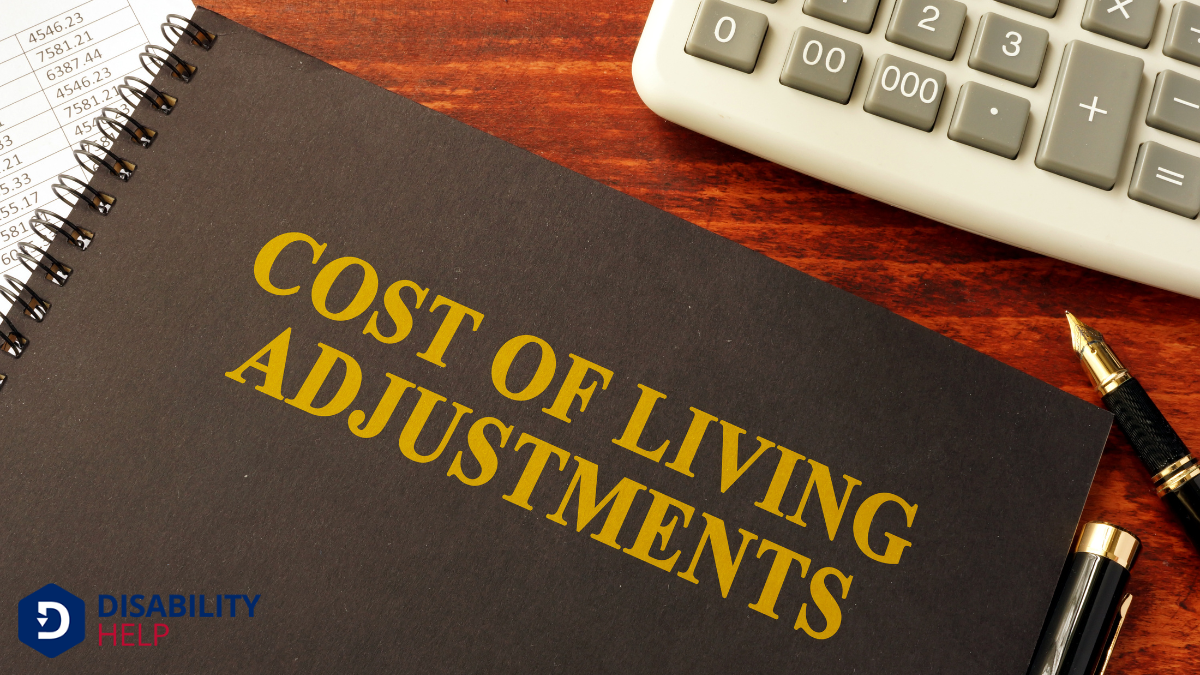When it comes to determining how much SSDI we'll receive, it's important to understand the various factors that come into play. Our Average Indexed Monthly Earnings (AIME) and Primary Insurance Amount (PIA) are key components in this calculation. Additionally, annual Cost-of-Living Adjustments (COLA) can impact our benefits. Let's explore how these elements work together to determine our SSDI amounts and what we can do to estimate our future payments.
Key Takeaways
- SSDI benefits depend on your AIME, which is calculated from your highest-earning years and adjusted for inflation.
- Your Primary Insurance Amount (PIA) uses a formula with progressive percentages applied to segments of your AIME.
- Annual COLA adjustments ensure SSDI benefits keep pace with inflation, based on the CPI-W index.
- SSDI eligibility and benefit amount require earning enough work credits from paying Social Security taxes.
- Other income sources, like substantial gainful activity, may reduce your SSDI benefit amount.
Understanding SSDI Eligibility Requirements
To understand how much SSDI you'll get, we first need to explore the eligibility requirements.
The Social Security Disability Insurance (SSDI)A U.S. government program that provides financial assistance to individuals who are unable to work d... program requires us to meet specific criteria. We must have a medical condition that qualifies as a disability under Social Security's definitions. This condition must prevent us from performing substantial gainful activity and be expected to last at least one year or result in death.
Additionally, we need to have earned enough work credits, which are based on our total yearly wages or self-employment income. Generally, we earn up to four credits per year.
The number of credits needed depends on our age and when we became disabled. Understanding these foundational requirements helps us determine the benefits we might receive.
The Role of Your Earnings Record

Our earnings record plays an essential role in determining the amount of SSDI benefits we receive. It reflects our work history and the income we've earned over the years. The Social Security Administration (SSA) uses this record to calculate our potential benefits.
Each year we work and pay Social Security taxes, we build credits; these credits are vital to accessing SSDI. Importantly, our earnings record also impacts our Primary Insurance Amount (PIA), which directly influences our monthly benefit.
Ensuring the accuracy of our earnings record is important. Mistakes on our record can lead to incorrect benefit calculations. Regularly checking our Social Security Statement helps us spot errors.
Calculating Your Average Indexed Monthly Earnings (AIME)
Diving into the calculation of our Average Indexed Monthly Earnings (AIME) gives us a clearer picture of how our SSDI benefits are determined.
To start, we gather our earnings record, focusing on the years with the highest income. We then apply an indexing factor to adjust these past earnings for inflation, ensuring they reflect today's economic conditions.
Next, we select the highest 35 years of indexed earnings and calculate the average. By dividing the total by the number of months in these years, we arrive at our AIME.
This figure is vital, as it forms the basis for determining our SSDI benefits. Understanding AIME helps us see how our work history and earnings impact our financial future with SSDI.
Primary Insurance Amount (PIA) Explained
Now that we've covered your Average Indexed Monthly Earnings (AIME), let's explore how we calculate the Primary Insurance Amount (PIA) using this figure.
The formula involves applying bend points, which determine how much of your AIME contributes to your PIA.
Understanding these points and their impact helps us estimate the SSDI benefits we can anticipate.
Calculating PIA Formula
Understanding how the Primary Insurance Amount (PIA) is calculated is essential for determining your Social Security Disability InsuranceA form of insurance that provides income to individuals who are unable to work due to a disability. (SSDI) benefits.
The PIA is the basis of what we’ll receive monthly, so let’s break it down. The calculation involves three progressive percentages applied to portions of our Average Indexed Monthly Earnings (AIME). These portions are defined by "bend points," which change annually.
First, we apply a 90% rate to the initial segment of our AIME. Next, we apply a 32% rate to the AIME amount between the first and second bend points. Finally, a 15% rate applies to any AIME exceeding the second bend point.
Average Indexed Monthly Earnings
Grasping the concept of Average Indexed Monthly Earnings (AIME) is vital for anyone looking to understand their Social Security Disability Insurance (SSDI) benefits. AIME is an important figure used to calculate our Primary Insurance Amount (PIA), which then determines our monthly SSDI payments.
Fundamentally, AIME helps us understand how our past earnings affect our future benefits.
To calculate AIME, the Social Security Administration (SSA) indexes our past earnings to reflect historical wage growth. They then average our highest-earning years, typically the 35 years where we earned the most.
Bend Points Impact
While calculating our Social Security Disability Insurance (SSDI) benefits, the concept of bend points in the Primary Insurance Amount (PIA) plays a crucial role.
These bend points determine how our Average Indexed Monthly Earnings (AIME) convert into our monthly benefits. Fundamentally, they’re thresholds that apply different percentages to portions of our AIME. The Social Security Administration updates these points annually, affecting how our benefits are calculated.
For example, the first bend point applies a higher percentage, so earnings below this point greatly impact our benefit amount. As we pass each bend point, the percentage decreases, meaning additional earnings contribute less to our final benefit.
Understanding these bend points helps us see how our earnings history translates into SSDI benefits, guiding financial planning.
How Cost-of-Living Adjustments Affect Your Benefits

Cost-of-living adjustments, often referred to as COLA, play a crucial role in determining the amount of Social Security Disability Insurance (SSDI) benefits we receive.
In essence, COLA guarantees that our benefits keep pace with inflation, preserving our purchasing power. Each year, the Social Security Administration evaluates changes in the cost of living based on the Consumer Price Index for Urban Wage Earners and Clerical Workers (CPI-W). When inflation rises, COLA increases our benefits accordingly.
- Inflation Protection: COLA helps safeguard our benefits from losing value over time.
- Annual Evaluation: Adjustments are made yearly to reflect economic changes.
- Automatic Adjustments: We don’t need to apply; they’re automatically calculated.
- Not Guaranteed: In years without significant inflation, we mightn't see a COLA increase.
Understanding COLA helps us anticipate changes in our SSDI benefits.
The Impact of Work Credits on SSDI
Understanding how work credits affect our SSDI benefits is essential for planning our financial future.
Work credits are like building blocks that we earn through our employment history. Each year, we can earn up to four credits, depending on our income. These credits determine not only our eligibility for SSDI but also influence the amount we receive.
Generally, to qualify for SSDI, we need a certain number of credits based on our age at the time of disability. The more credits and higher earnings we've accumulated, the better our potential benefits.
It's important to track our work history and guarantee we're meeting the necessary requirements. Staying informed helps us secure the benefits we've worked hard to earn.
Estimating Your SSDI Payment
How exactly do we estimate our SSDI payment? First, we need to understand that our payment is based on our average lifetime earnings before our disability. The Social Security Administration (SSA) uses a complex formula to calculate our Primary Insurance Amount (PIA), which determines our monthly SSDI payment.
Here’s a simplified path to get a clearer picture of what to expect:
- Review your earnings record: Verify your work history is accurate, as it directly impacts the calculation.
- Use the SSA's online calculator: This tool provides a personalized estimate based on our own earnings record.
- Understand your PIA: It’s the basis for our monthly benefit and is calculated using our highest-earning years.
- Seek professional advice if needed: Experts can help us navigate the nuances of our specific situation.
Factors That Can Reduce Your Benefit Amount

While estimating our SSDI payment provides us a baseline, several factors can influence and potentially reduce the final amount we receive. One critical factor is any work income we might earn. If we're engaged in substantial gainful activity (SGA), our benefits could be affected.
Additionally, receiving other disability benefits, like workers' compensation or certain public disability payments, can lead to what's called an "offset," reducing our SSDI. Overpayments from the Social Security Administration can also occur and might require repayment, thereby impacting our benefits.
Finally, filing errors or changes in our personal circumstances can lead to adjustments. It’s important to stay informed and vigilant about these variables to guarantee that we're receiving the correct benefit amount.
How to Access Your Social Security Statement
Let's explore how we can access our Social Security Statement to get a clear picture of our benefits.
We'll start by setting up an online account, which will allow us to view important statement information and check our benefit estimates easily.
This step will help us understand how much SSDI we might receive and plan accordingly.
Online Account Setup
Creating an online account with the Social Security Administration (SSA) is an essential step in accessing your Social Security Statement effortlessly.
Let's walk through this process together so we can view our benefits and contributions with ease. First, we need to visit the SSA's official website and locate the "my Social Security" section.
Here’s what we should consider:
- Security: Confirm our personal information is safe by using a strong password.
- Verification: Be prepared to verify our identity through security questions.
- Access: With our account, we can check earnings records anytime.
- Updates: Keep our contact information current for future correspondence.
Statement Information Overview
How can we easily access our Social Security Statement to keep track of our benefits and contributions? We can do this by logging into our "my Social Security" account online.
This secure portal offers a thorough view of our earnings history and projected benefits, whether we’re planning for retirement or just curious about our contributions.
First, confirm we’ve set up our account, which was covered in the previous section. Once logged in, we’ll find our statement under the "Your Social Security Statement" section.
It’s essential to regularly review this information to verify its accuracy and understand our financial standingThe legal right to bring a lawsuit, which requires that the individual bringing the suit has a direc.... By staying informed, we empower ourselves to make well-informed decisions about our future Social Security benefits.
Checking Benefit Estimates
Curious about how much we might receive in Social Security Disability Insurance (SSDI) benefits? We can easily find out by checking our Social Security Statement.
It's an essential step because it provides a personalized estimate based on our work history and earnings. Accessing this information is simple and can be done online. Here’s how:
- Create or log into a "my Social Security" account: This is the starting point for accessing our statements.
- Verify our identity and personal details: Guarantees security and accuracy in the information we receive.
- Review our earnings record: Helps us confirm all income is correctly reported, affecting our benefit estimates.
- Check estimated benefits: Gives us insights into potential SSDI amounts based on our current work record.
Understanding these steps empowers us to make informed financial decisions.
Planning Your Finances With SSDI Benefits
While planning our finances with SSDI benefits, it’s essential to understand how these payments fit into our overall financial picture. We need to account for regular monthly expenses like housing, utilities, groceries, and healthcare.
By creating a detailed budget, we can prioritize these needs and avoid overspending. Let’s also consider any additional income sources we might have, such as part-time work or other benefits, to get a complete view of our financial resources.
It’s vital to set aside a portion of our benefits for unexpected expenses or emergencies. We should explore ways to manage our money wisely, like opening a savings account or seeking financial advice.
Conclusion
In summary, we've explored how our earnings history, AIME, and PIA come together to determine SSDI benefits. By understanding these elements and the impact of COLA, we can better estimate our payments. It's vital to regularly check our Social Security Statement for accuracy to guarantee we're on track. Remember, several factors can reduce benefits, so planning ahead is important. By staying informed, we can manage our finances effectively with SSDI support.






